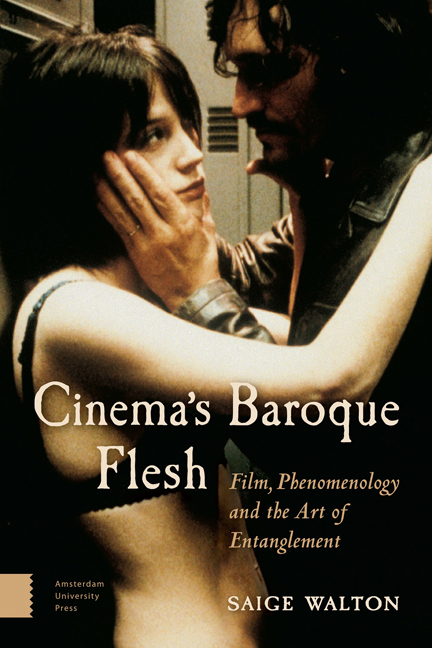Book contents
- Frontmatter
- Dedication
- Contents
- Acknowledgements
- Introduction
- 1 Flesh, Cinema and the Baroque: The Aesthetics of Reversibility
- 2 Knots of Sensation: Co-Extensive Space and a Cinema of the Passions
- 3 Baroque Skin/Semiotics
- 4 One Hand Films the Other: Baroque Haptics
- Conclusion: Or the Baroque ‘Beauty of the Act’
- Notes
- Bibliography
- Filmography
- Index
1 - Flesh, Cinema and the Baroque: The Aesthetics of Reversibility
Published online by Cambridge University Press: 12 February 2021
- Frontmatter
- Dedication
- Contents
- Acknowledgements
- Introduction
- 1 Flesh, Cinema and the Baroque: The Aesthetics of Reversibility
- 2 Knots of Sensation: Co-Extensive Space and a Cinema of the Passions
- 3 Baroque Skin/Semiotics
- 4 One Hand Films the Other: Baroque Haptics
- Conclusion: Or the Baroque ‘Beauty of the Act’
- Notes
- Bibliography
- Filmography
- Index
Summary
If we can show that the flesh is an ultimate notion, that it is not the union or compound of two substances, but thinkable by itself, if there is a relation of the visible with itself that traverses me and constitutes me as a seer, this circle which I do not form, which forms me, this coiling over of the visible upon the visible can traverse, animate other bodies as well as my own.
– Maurice Merleau-Ponty (VI, p. 140)[A]bove all it is the […] provocative quality of the gesture which is baroque.
– Walter Benjamin (The Origin, p. 183)For Merleau-Ponty, any ‘philosophy of perception which aspires to learn to see the world once more […] will restore painting and the arts in general to their rightful place’ (World of Perception, pp. 93–94). By establishing the ontological structures and conditions that underpin baroque flesh, this chapter will give us pause to consider why this aesthetic is so amenable to film. While turning perception ‘inside out’ to make it sensible to others could be considered through alternative aesthetic models, reversibility bears a very special relationship to the baroque. As I argue it, in baroque flesh we find the aesthetic expression of much of what Merleau-Ponty has to tell us about embodied being and perception.
Just as ‘flesh’ speaks to shared but not coincident relations, the baroque of art and film hinges upon doubling and reversibility. Baroque flesh is embedded in a structural circularity: ‘every perception is doubled with a counter-perception […] an act with two faces’ as Merleau-Ponty writes (VI, p. 264). In starting to explore the relationship between cinema and the baroque more closely, this chapter will establish the baroque as its own phenomenology of vision: mobile, multiple, prismatic, and highly theatrical. By way of Strange Days and Caché, I argue that a baroque ‘way of seeing’ manifests itself in film through perceptual flux and through a self-reflexive gesturing towards the viewer, towards the medium, and towards what Sobchack calls the ‘film's body’ (Klein, Vatican to Vegas, p. 12; Sobchack, Address of the Eye, pp. 164–259).
- Type
- Chapter
- Information
- Cinema's Baroque FleshFilm, Phenomenology and the Art of Entanglement, pp. 29 - 78Publisher: Amsterdam University PressPrint publication year: 2016



